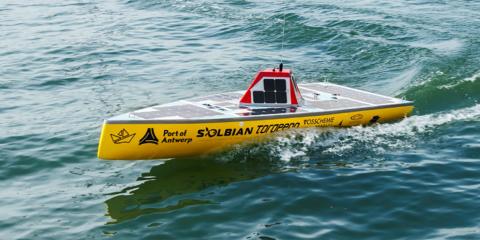Team sends unmanned boat across the Atlantic ocean

Team sends unmanned boat across the Atlantic ocean
The development of unmanned vehicles is gaining importance in various industries. 4 Flemish engineers now want to be the first to have an autonomous, unmanned boat crossing the Atlantic Ocean, while automatically transmitting air and water quality data to the mainland. Flanders Make sponsors the initiative and provides the necessary infrastructure to move the project forward.
One of the engineers, Pieter-Jan Note, works for Flanders Make as Core Lab Manager and talks enthusiastically about his project: "In 2015, we had the wild idea to set up a joint innovative and challenging project after our studies. We saw potential in capturing ocean data through an unmanned boat." At the moment, this is still being carried out by large polluting boats with a large number of crew members. Pieter-Jan believes it can be done in a more efficient and sustainable way.
The project is named after the Mahi, a colourful ocean fish. It is so fast and agile that it is almost the only fish species that can catch flying fish. Thanks to cameras and antennas, the Mahi boat can independently dodge objects and capture and interpret information from nearby vessels and, subsequently, adjust its course. Intelligent sensors transmit air and water quality data to the mainland for ocean analysis purposes. Due to the absence of crew and the fact that the boat sails entirely on solar energy, this could generate a sustainable and financial win-win situation for the shipping industry.
"These technologies are widely available today and make it possible to develop this in-house with a small team", says Pieter-Jan. The electronics, software development, sensors, GPS and construction of the 4 metre long basalt composite boat were all put together in their spare time.
4 years of testing
After 4 years of testing, a first prototype was launched for a crossing in 2019. "The first attempt was not an unqualified success, but it was a valuable beta-test", Pieter-Jan says with a smile. "The boat did very well but ended up in a storm, capsized several times and unfortunately stayed upside down. It was an instructive period in which, as in a typical engineering project, we had to learn from our mistakes." After a perilous rescue operation, the boat is now being prepared for another attempt in the autumn of 2021.
Thanks to sponsors such as Flanders Make, the team can free up a budget for new electronics that are more resistant to the saltwater environment and invest in improving the stability of the boat. The use of flexible solar panels was validated in the climate chamber with sunlight simulation of Flanders Make. Flanders Make has the necessary in-house knowledge and infrastructure for this as this technology is also interesting for the automotive industry.
Meanwhile, Pieter-Jan continues dreaming. “Columbus had a go on the crossing 500 years ago with 3 ships and 100 crew members. Now a light boat will soon be able to sail this route completely autonomously. Moreover, there is no large maritime organisation behind this but just 4 Flemish engineers with a heart for innovation. After all, not that bad”, jokes Pieter-Jan.
